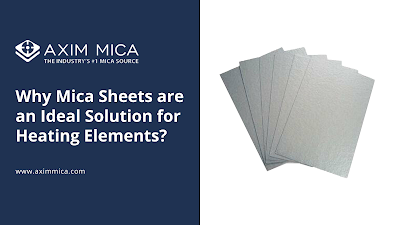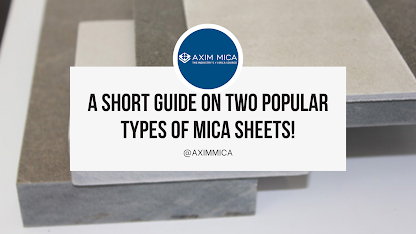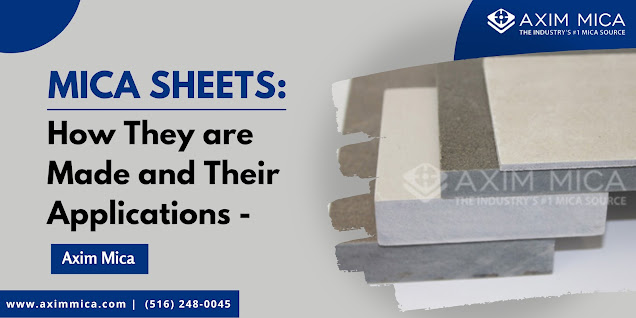Why Mica Sheets are an Ideal Solution for Heating Elements?
Mica Sheets have become an increasingly popular solution for heating elements in recent years, and for good reason. In this blog post, we'll explore why mica sheets make such an ideal heating material.
What is Mica?
Mica is a naturally occurring silicate mineral in metamorphic and igneous rock formations. It has a unique sheet-like structure that allows it to be split into thin, flexible sheets.
Some critical properties of mica that make it well-suited for heating elements include:
Excellent thermal stability and heat resistance: Mica has a very high melting point of 1,200°C, making it withstand extremely high temperatures.
Electrical insulation: Mica has high dielectric strength and acts as an electrical insulator. This prevents current leakage in heating applications.
Low thermal conductivity: Mica conducts heat slowly, allowing it to maintain stable temperatures.
Flexibility: Thin mica sheets are flexible and can be formed into various shapes.
Benefits of Mica Sheets for Heating Elements
There are several significant benefits to using mica sheets for heating element construction:
Uniform Heating
The layered structure of mica allows for uniform heating across the entire surface of the element. This results in efficient, even heat distribution without hot spots.
Durability
Mica's heat resistance provides durability at high temperatures. Mica elements can have a longer service life than other materials. This reduces the need for frequent replacements.
Electrical Insulation
Mica's excellent electrical insulation prevents current leakage and short-circuiting in heating elements. This enhances safety and reliability.
Temperature Resistance
Mica remains stable at temperatures up to 1,200°C. This high heat tolerance allows mica heating elements to withstand the extreme temperatures required for applications like furnaces, ovens, and other industrial processes.
Lightweight Construction
Mica sheets can be split into very thin thicknesses while providing functional mechanical strength. This results in lightweight heating elements that are easier to work with.
Design Flexibility
The thin, flexible sheets can be bent, curled, or conformed into various shapes. This allows for more flexible heating element designs to meet specific application needs.
Mica Battery Insulation
In addition to heating elements, mica plays a critical role as battery insulation in many modern battery technologies. Its electrical insulation properties help prevent short circuits and enhance battery safety. Recent advances in mica battery insulation include:
Ultra-thin sheets that maximize energy density in compact batteries.
Enhanced chemical resistance to battery electrolytes for longer service life.
Improved thermal conduction to maintain optimal battery temperatures.
Higher dielectric strength for electrical insulation even at minimal thicknesses.
Mica Paper
Mica paper is a composite material composed of mica flakes and binders. The mica flakes reinforce the paper and enhance thermal and electrical insulation properties. Key advantages of mica paper include:
It withstands temperatures up to 500°C while remaining flexible.
Excellent electrical insulation, even when saturated with varnish or oil.
Resists scorching and charring when exposed to arcs or sudden high temperatures.
It can be wrapped around heating elements to provide additional insulation.
Used as phase insulation in electric motors and transformers.
Flexible Mica Sheets
Flexible mica sheets provide the insulating and heat-resistant properties of mica in a thin, bendable form. These flexible sheets allow mica insulation to be applied in applications where rigid mica plates won't suffice. Benefits include:
It can be wrapped around curved or irregularly shaped surfaces.
Allows for insulation in confined spaces.
Easy to cut and shape for custom applications.
Maintains insulation value even when flexed or compressed.
Available with adhesive backing for easy attachment.
Flexible mica sheets have opened new doors for mica-based insulation, from electric motor windings to small electronics.
Heating Element Applications
With their unique set of properties, mica sheets have become an indispensable material for the construction of heating elements used in:
Electric baseboard heaters
Ceramic heaters
Industrial furnaces and ovens
Heat pumps
Clothes irons
Space heaters
Deep fryers and cooking appliances
Water heaters
Heat presses
And many other heating equipment both for residential and industrial use.
The Wrap
Mica sheets provide the durability, efficient heating, and electrical insulation needed in these demanding high-temperature applications. In the long run, contacting a reliable manufacturer and provider for these mica solutions is always advisable. One such name in the industry is Axim Mica, and they have been providing mica solutions for industrial purposes for decades. Contact Axim Mica today to fulfill your mica solution needs!





Comments
Post a Comment